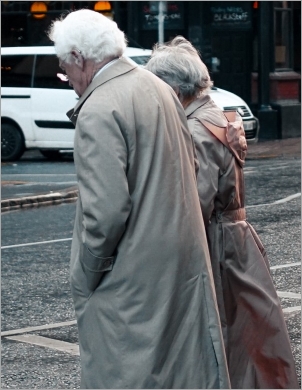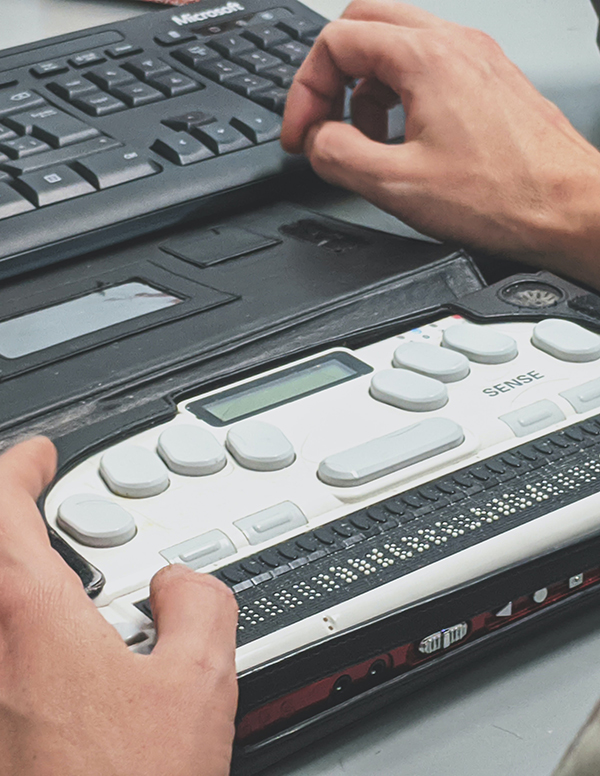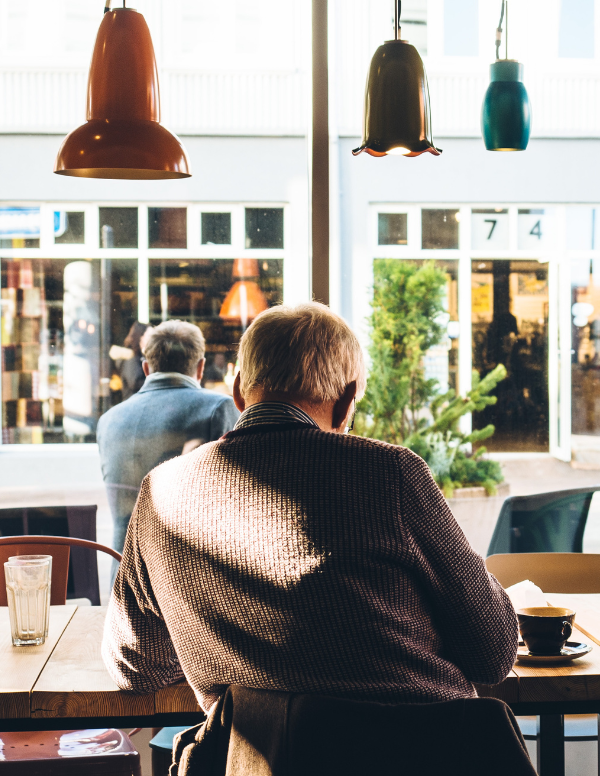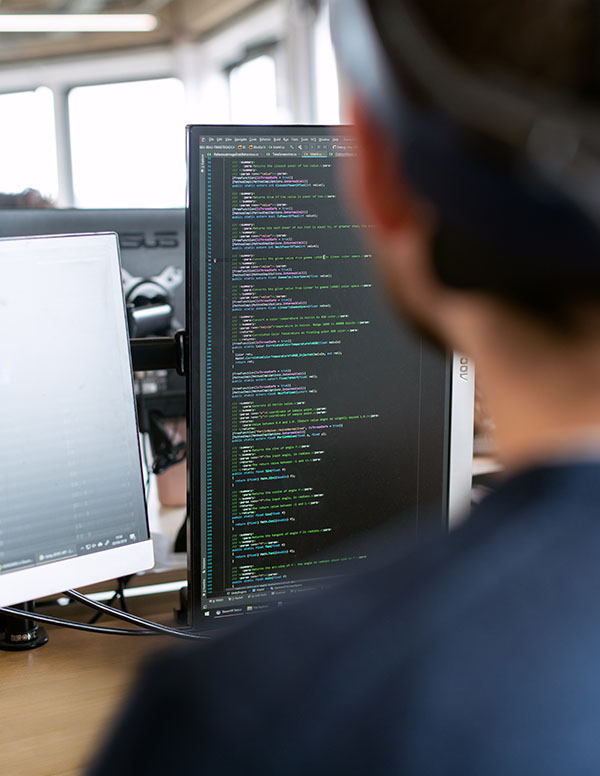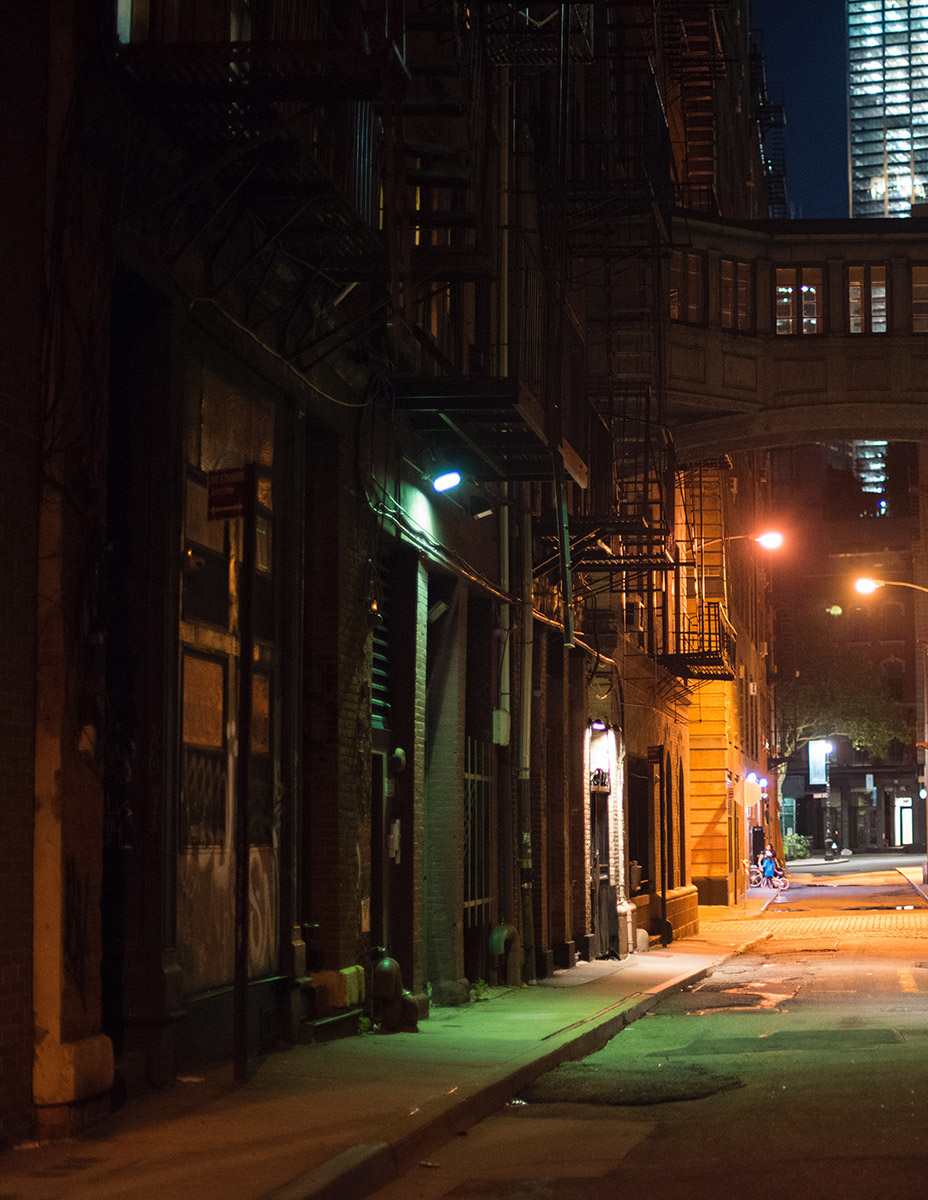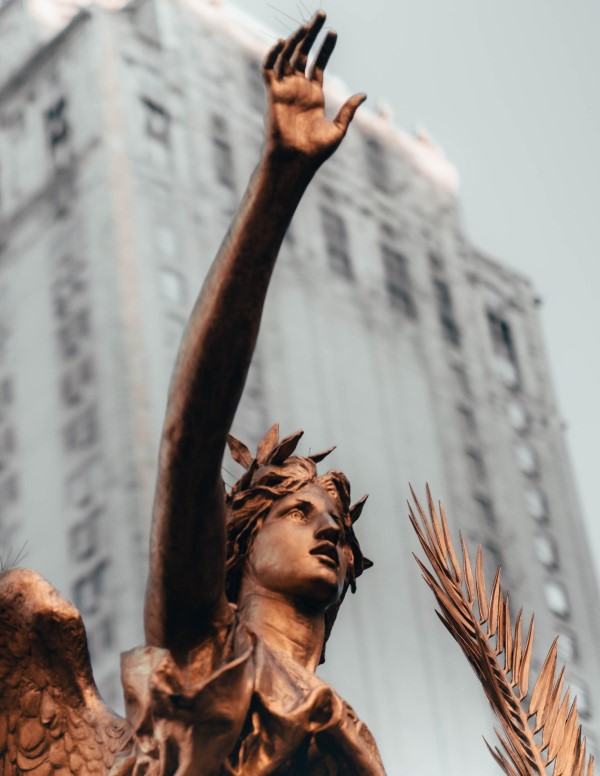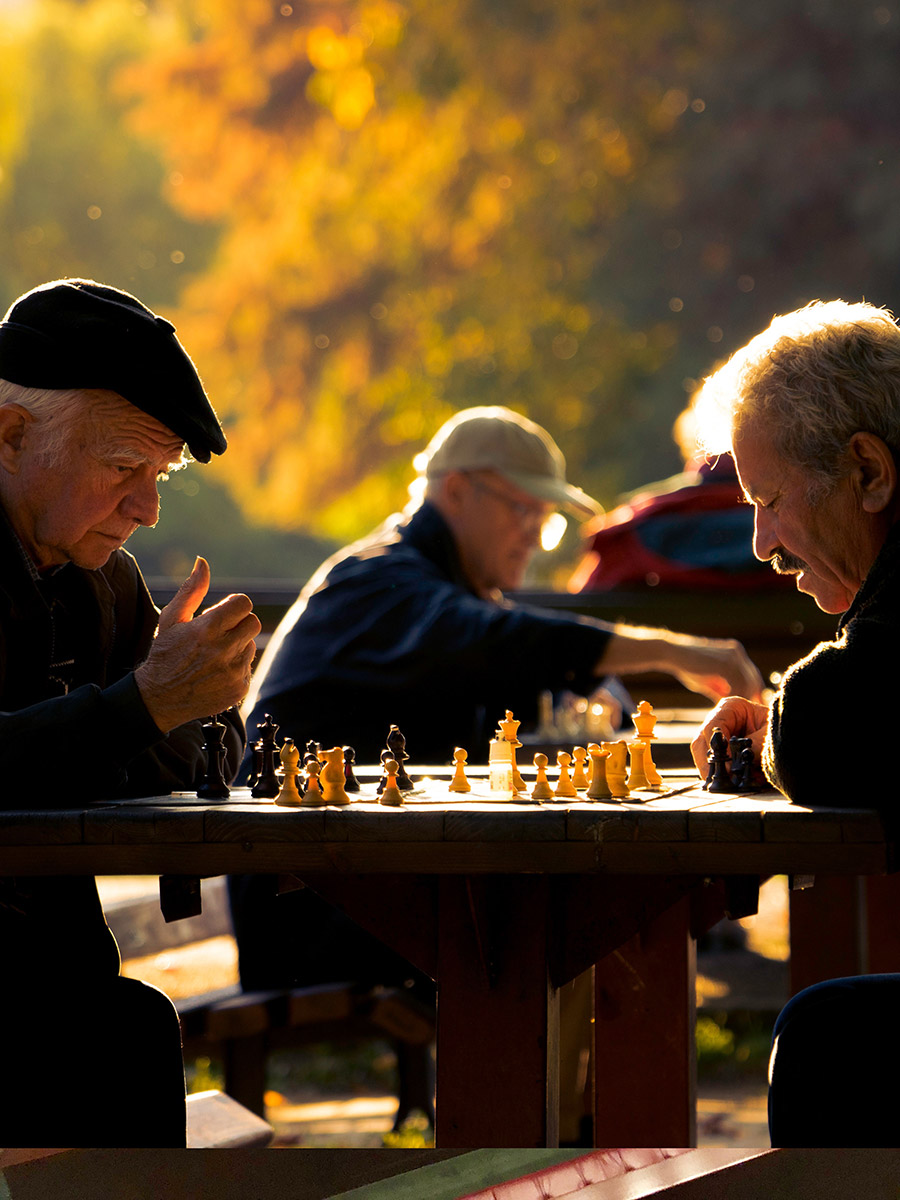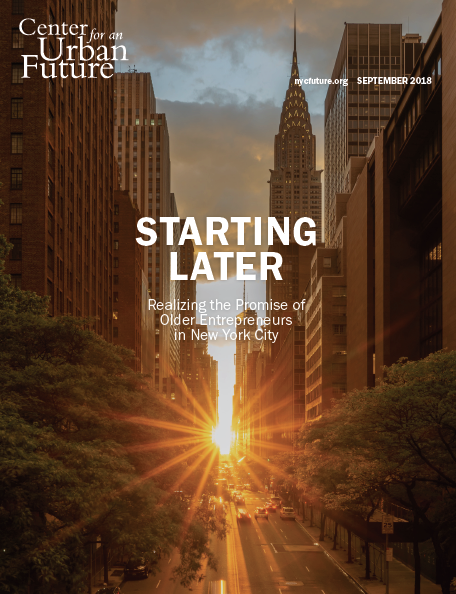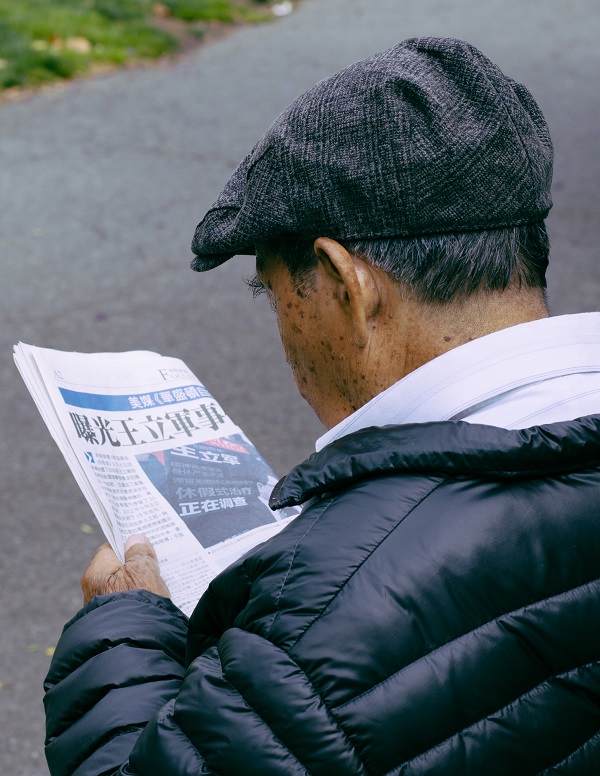The coronavirus pandemic is devastating communities across New York, but the impacts have been especially severe for the city’s large and growing older adult population.
New York City is home to more than 1.7 million people age 60 and over, an all-time high. This includes more than 141,000 residents who are over the age of 85, more than 136,000 who are homebound, and one in five who are living below the federal poverty line. Older New Yorkers not only account for the lion’s share of deaths from the virus—70 percent of those succumbing to the virus were age 65 and over as of April 1, 2020—they are also facing unprecedented barriers accessing meals, groceries, medicine, and support services. Many are struggling with new levels of social isolation, compounded by the temporary closure of most senior centers, libraries, settlement houses, restaurants, and houses of worship.
City and state policymakers have taken some important steps to support older New Yorkers during this crisis, and hundreds of nonprofit organizations serving older adults are providing a vital lifeline. But with so many older New Yorkers facing new threats to their health, safety, and social and emotional well-being, New York policymakers will undoubtedly need to do even more to ensure the city’s older adults are cared for during this crisis. At the same time, communities are losing access to the knowledge and volunteerism of older people amid widespread closures and enforced social distancing, placing additional burdens on organizations citywide.
To get a better sense what should be done to support older adults amid the pandemic, we reached out to nearly two dozen experts in older adult services for specific recommendations as to what city and state policymakers should do right now. We received input from the leaders of senior-serving organizations across all five boroughs including Citymeals on Wheels, United Neighborhood Houses, BronxWorks, and JASA; from executives and front-line staff at community centers, caregiving organizations, settlement houses, and libraries; from leading city and statewide advocacy organizations; and from experts who work with immigrant and LGBTQ older adults and those with disabilities, among other particularly vulnerable populations.
All together, we received more than 40 specific ideas. They include supporting the development of technology to reach socially isolated older New Yorkers, bolstering telehealth services, mobilizing laid-off workers to increase the output and delivery of take-home meals, and developing a central information portal to communicate important updates and resources to seniors and providers. There was also a clear consensus that the city needs to provide more support to the nonprofit organizations serving older adults, by increasing flexibility and funding contracts at levels that accurately reflect the full cost of service delivery.
NYC Older Adult Services Experts’ Recommendations for Immediate Action
- Create a centralized intake process to expedite meal delivery to seniors
- Draft volunteers to phonebank to older adults to reduce isolation
- Expand virtual and remote programming for older adults and hold participatory online classes to increase social engagement
- Provide technology to allow community-based organizations (CBOs) to engage seniors in the emergency response, create virtual support groups, and send informational updates on neighborhood resources
- Repurpose senior centers into community kitchens to combat food insecurity
- Hire laid-off workers—such as food service professionals— to increase staffing of community kitchens and expand services for homebound older adults
- Lift restrictions on telehealth care, including behavioral health
- Redeploy senior center staff and volunteers to combat social isolation
- Build up trusted delivery network to provide home-delivered essentials
- Target free meal distribution and services to buildings—from NYCHA to NORCs—that house older adults with disabilities but lack built-in senior centers
- Designate accessible shelters in each borough for homeless older adults
- Strengthen emergency planning and coordination and pre-supply older adults with food to ensure continuity in the event of service disruption
- Develop virtual intergenerational programming to increase socialization and connection
- Expand access to technology and training
- Guarantee the same protections to human services case workers as first responders
- Rapidly expand the workforce training pipeline for direct care workers
- Incentivize caregiving for families
- Expand data sharing between city agencies and nonprofits
- Loosen restrictions on current contracts to enable flexible emergency response
- Provide information on senior services in multiple languages, including instructions for home-delivered meals
- Increase awareness of benefits and exemptions programs and access to housing assistance
- Create new systems to help older adults access information and services
- Provide nonprofits with no-interest loans
- Prepare to extend service contracts if budget deadlines are missed
- Rally funding for existing organizations
- Fully fund human services contracts to guarantee efficient response
- Expand Access-A-Ride service
- Create population-specific guidance on closing facilities to protect older adults
This report features insights and ideas from the following individuals:
Katelyn Andrews, Director of Public Policy, LiveON NY
Ed Friedman, Executive Director/Co-Founder of Lifetime Arts, Inc.
Terry Kaelber, Director of the Institute for Empowered Aging at United Neighborhood Houses of NY
Gregory J. Morris, President and Executive Director of Stanley M. Isaacs Neighborhood Center
Nancy Harvey, Chief Executive Officer of Service Program for Older People (SPOP)
Darren Bloch, CEO of Greenwich House
Nancy D. Miller, Executive Director/CEO of VISIONS/Services for the Blind and Visually Impaired
Beth Shapiro, Executive Director, Citymeals on Wheels
Wayne Ho, President & CEO of Chinese-American Planning Council, Inc.
Kathryn Haslanger, Chief Executive Officer at JASA
Jodi M. Sturgeon, President, PHI
Isabel Ching, Executive Director at Hamilton-Madison House
Kyung Yoon, President of Korean American Community Foundation
Eileen Torres, Executive Director, BronxWorks
Maria Alvarez, Executive Director of NY StateWide Senior Action Council
Lindsay Goldman, Director, Healthy Aging at New York Academy of Medicine
Vasundhara Kalasapudi, Executive Director at India Home Inc.
Bobbie Sackman, Member Leader at of NY Caring Majority Coalition/JFREJ
Scott Short, Chief Executive Officer of RiseBoro Community Partnership
Anderson Torres, President and CEO of R.A.I.N. Total Care
Lyman Clayborn, Coordinator of Older Adult Services at Brooklyn Public Library
Melissa Aase, Executive Director of University Settlement
Aaron Tax, Director of Advocacy at SAGE
Katelyn Andrews
Director of Public Policy
LiveOn NY
Create a centralized intake process to expedite meal delivery to seniors
There is currently a herculean effort afoot to ensure that older adults—the population most vulnerable to the disease—have access to proper nutrition throughout the outbreak. This effort is uniquely challenging, as there is no singular entry point to reach all older adults who might need a meal, as is provided through the education system. The city’s home-delivered meal system currently serves a daily meal to roughly 18,000 older adults and the senior center system, which is currently being modified to act as a parallel take-out and home-delivered meal system, serves roughly 30,000 seniors. However, according to the 2018 American Community Survey one-year estimate, more than 1.73 million New Yorkers are over the age of 60.
It is critical that the city create a centralized intake process (an online portal and clear system through 3-1-1 or Aging Connect) to expedite new senior home-delivered meal requests during this time. The city should also work with its partners to proactively reach out to seniors who might be in need. It’s possible that the new needs will range in the hundreds of thousands, which will require innovative solutions to meet this demand and would most certainly exhaust the capacity of the existing senior meals system. The system should partner with local restaurants that may be struggling under current circumstances but may have capacity to churn out hundreds of meals for at-risk neighbors (and may even have experience in delivery, too). Taxi drivers, hard-hit even before the pandemic, can also be recruited to deliver the meals, as is currently and admirably being explored by the city.
Ed Friedman
Executive Director/Co-Founder
Lifetime Arts, Inc.
Draft volunteers to phonebank to older adults to reduce isolation
Ask each senior center, as well as any other organization that serves a substantial older adult population (e.g., religious institutions) to enlist a group of volunteers and staff to help make phone calls to every registrant, three times a week. At minimum, those who live alone will feel less isolated, and if there’s a dire problem, the organization sponsoring the volunteers may be able to solve it.
Hold participatory online classes to increase social engagement
Use the Internet (and the phone for people without Internet access) to hold participatory art classes in all arts disciplines (literary, performing, visual). This will provide meaningful social engagement among participants as well as a meaningful activity that doesn’t have to focus on the epidemic. In addition, it’s a jumping off point for participants to expand their social network beyond these classes. Cultural and arts education organizations can partner with organizations that serve older adults for purposes of outreach.
Terry Kaelber
Director, Institute for Empowered Aging
United Neighborhood Houses of NY
Provide technology to allow CBOs to engage seniors in the emergency response, create virtual support groups, and send informational updates on neighborhood resources
As many older people age, social isolation and loneliness become major challenges, negatively impacting quality of life and health. With the arrival of the coronavirus, this challenge is intensified as New Yorkers are being asked to stay at home and limit social contacts. For many older people, quality of life suffers and health deteriorates—even for those who do not have the coronavirus. And for the many organizations that rely on the skills and knowledge of older people who step forward as community activists working to address local issues and challenges, and helping to deliver important programs and services, the isolation of older people adds another burden to communities during this crisis.
To mitigate these challenges, government at all levels must:
- Encourage and support innovation, including:
- Provide resources to CBOs to access and use conference call and video streaming technologies to support virtual support groups, discussion groups, exercise, and other programming.
- Develop phone trees, where CBO staff work with older people to conduct daily check-in calls, thereby activating existing friendship and support networks.
- Engage older people in the planning and execution of community responses to the coronavirus, similar to the role many played during Superstorm Sandy.
- Provide informational updates on the virus, including area businesses providing free home delivery (pharmacies, grocery stores, restaurants, etc.), and who to call in the case of illness.
- Provide flexible support to CBOs who have relationships with older people in local communities.
Gregory J. Morris
President and Executive Director
Stanley M. Isaacs Neighborhood Center
Repurpose senior centers into community kitchens to combat food insecurity
New York’s nearly 250 senior centers and affiliated sites, which provide more than 7.5 million meals each year, should be transitioned into community kitchens to produce meals in support of older adults and other vulnerable community members in need. Under normal circumstances, these sites, operated by exceptionally skilled and too often underpaid professionals, are responsible for the food intake and nutrition of thousands of older adults. They are also capable of producing take home meals as needed during weekends and holidays. With additional personnel and provisions, these kitchens can double or triple current meal production by expanding their hours of operation, and utilizing a “Grab and Go” style of meal distribution.
Hire laid-off food service professionals to boost staffing of community kitchens and increase output of take-home meals
With the mandated closure of restaurants and bars, there are food service professionals who are available for hire right now to supplement existing staff, and likely interested vendors whose businesses have been affected by the shutdown. The benefits of having senior centers serve as the focal points of meal production are two-fold: 1) Senior centers are trusted and reliable service hubs physically embedded with vulnerable neighborhoods including public housing developments. 2) Directing economic resources to communities-in-need during a time of crisis supports the immediate welfare of residents, businesses, and service providers, and creates the opportunity for longer-term interest and investment in historically underserved and under resourced neighborhoods.
Nancy Harvey
Chief Executive Officer
Service Program for Older People (SPOP)
Lift restrictions on telehealth care, including behavioral health
The single most important action government can take to support organizations like SPOP that provide behavioral health care for older adults would be the permanent lifting of public payor (Medicare and Medicaid) restrictions for telehealth care, including behavioral health care. Telehealth is health care for those who are homebound, disabled, isolated, or unable for any reason to travel for a medical appointment, and its widespread implementation on an emergency basis during the COVID-19 outbreak shows that it is the way of the future.
Telehealth coverage of behavioral health care for older adults is long overdue. Our clients are far more tech-savvy than just ten years ago, and they have shown that they are fully receptive to a virtual connection via computer or secure phone. Most important, in-home psychotherapy can help reduce unnecessary hospital emergency room usage associated with psychological disorders.
Our highest priority is to keep older adults healthy and in their homes during the COVID-19 outbreak. Public payor coverage of telehealth is enabling SPOP to provide comprehensive behavioral health care to those most at-risk, while we all learn what it means to be homebound and isolated.
Darren Bloch
CEO
Greenwich House
Expand and improve food access services
If we are telling adults over 60 to truly self-isolate, then we need to prop up much more robust food access options. This could include making everyone over the age of 60 eligible for a free meal delivery program, and supporting that meal program through new alternative supply chains run by agencies other than DFTA. The city and state could also use existing massive meal preparation infrastructure (sports arenas, colleges, and cultural institutions) and existing delivery logistics chains to support further expansion. Policymakers might also target clusters of seniors in NORCs by partnering a site with a local or proximate food vendor. For instance, we are trying to work with Westbeth Artist Housing, Independence Plaza, and West Village Houses to understand their food access needs and then tracking down meals that we can deliver to the building, where building staff are delivering to tenant doors.
Redeploy senior center staff and volunteers to combat social isolation
With senior centers closed for congregate meals and programming, staff and volunteers should be shifted full time into senior outreach to all adults over 60 in their catchment area. Groups with contracts to do this work should be formally authorized, and everyone should be provided with contact lists and other resources, and linked into a centralized database to track and facilitate outreach.
Build up trusted delivery network to provide home-delivered essentials
If we want seniors to stay in place, we need to build up a trusted delivery network. The city should look to local CBOs to provide this type of program build up. Agencies should be encouraged to work with existing staff, but they should have latitude to supplement current teams with new logistics coordinators who have the skillsets to operationalize such a project.
Nancy D. Miller
Executive Director/CEO
VISIONS/Services for the Blind and Visually Impaired
Target free meal distribution and services to buildings—from NYCHA to NORCs—that house older adults with disabilities but lack built-in senior centers
Require the Mayor’s Office for People with Disabilities (MOPD) and the Department for the Aging (DFTA) to target and coordinate service continuation and free meal distribution for buildings that house a large number of older persons with disabilities. This could include NYCHA, Section 8, HUD 202, NORCs, supportive housing, and assisted living residences. DFTA is requiring senior centers to continue to offer meals for pick up, and this helps buildings that have in-building senior centers but not those that don't.
Designate specific, accessible shelters in each borough for homeless older adults
Immediately remove all older persons age 60 and over, including those with disabilities, from general homeless shelters and designate specific accessible shelters in each borough for older persons that include onsite health services, meals delivered or prepared for pick up, and access to free telehealth counseling billed to Medicaid and/or Medicare from organizations like Service Program for Older People (SPOP), Jewish Association for Serving the Aging (JASA) and others.
Beth Shapiro
Executive Director
Citymeals on Wheels
Strengthen emergency planning and coordination and pre-supply older adults with food to ensure continuity in the event of service disruption
An open-ended crisis, and one that impacts older people disproportionately, has posed unique challenges for Citymeals. Our COVID-19 response has focused on preparation of 450,000 shelf-stable emergency meals for older New Yorkers should home-delivered meals be interrupted. At the same time, the city's home-delivered meal program is considered an essential service. So we have also been working closely with our 30 meal centers partners, across the five boroughs, to help them sustain deliveries during this extremely difficult time. It has been especially challenging with some kitchens closing, delivery staff calling in sick or forced to stay home, using volunteers to make some deliveries at a moment’s notice. Some days it has been miraculous triage and other days barely controlled chaos.
To ensure a vital lifeline of meals for vulnerable seniors during any emergency, coordination and communication are key. Citymeals has been working with the city’s Department for the Aging and the Food Access Leadership Team (FALT), which operates under the NYC Office of Emergency Management. But more rigorous planning and coordination is needed from all agencies working on the emergency response, understanding that none of have ever worked on a crisis of this scope before. The extent of COVID-19 was impossible to know, but planning could and should have begun in January, or even early February, not March, when meals were needed immediately. Plans need to be in place to pre-supply older adults with food should there be a disruption in services.
Wayne Ho
President & CEO
Chinese-American Planning Council, Inc.
Redeploy laid-off workers to deliver resources, conduct wellness checks, and help prevent social isolation
Because many New Yorkers have lost their jobs recently, there is an opportunity to support these workers while meeting the immediate needs of older adults. During this time, older adults need food, medicine, personal protective equipment (PPE), and other resources, so the city can work with CBOs or through NYC Service to hire these laid-off workers to deliver resources, conduct wellness checks, and help prevent social isolation. The deliveries would have to be done in the safest way possible, respecting social distancing and cleanliness.
Develop virtual intergenerational programming to increase socialization and connection
Another way to combat social isolation and promote wellness would be to develop intergenerational programming between young people and older adults. CBOs would be needed to match young people and older adults. Technology, effective pairings/groupings, language, and other conditions would have to be addressed. For Chinese American older adults, WeChat would be the preferred, known platform.
Expand access to technology and training
Older adults need more access to technology, especially during this time when there are almost hourly updates and lots of misinformation. They need not only hardware and software but also training. This would be important for all older adults, especially immigrants and those with limited English proficiency. These older adults still need assistance translating bills (telephone, rent, utilities, etc.) and now need assistance translating health guidance. Video-conferencing technology is another way to address social isolation, support translation/interpretation, and continue adult literacy programming.
Kathryn Haslanger
Chief Executive Officer
JASA
Guarantee the same protections to human services case workers as first responders
City and state policymakers and emergency planners should recognize home care workers and certain human services case workers as lifelines for vulnerable at-risk people with disabilities and elderly community residents. They need the same privileges, protections, and supports as first responders and health care workers in the facility-based health care system, including:
- Access to special childcare arrangements (and elder care arrangements) so that they can continue to perform their essential roles
- Ability to move freely even after shelter-in-place or community travel restrictions are enacted
- Priority access to PPE so that they can stay safe and continue to perform their essential role.
The case for home care workers should be clear to everyone. The human services workers I am including are those who are providing cash and essential supports to those living in the community with impaired judgment—people determined by courts to require some level of support who have organizations like JASA appointed as their legal guardians. At this time, government is anticipating that home care workers and key human services workers will continue to carry out their responsibilities; they need the support of government policies, tools, and special designations to make that possible.
Jodi M. Sturgeon
President
PHI
Protect direct care workers and rapidly expand the workforce training pipeline
Direct care workers are a lifeline for many older adults and people with disabilities in New York City—and their contribution to the health and long-term care system has never been more apparent than during the COVID-19 pandemic. These workers—nearly 300,000 home care workers and nursing assistant across the city—are struggling against the odds to maintain their clients’ (and their own) health, prevent viral transmission, and facilitate treatment in place when clients become infected. To support older New Yorkers through this crisis, state and city leaders must ensure that direct care workers can continue to provide these vital services safely and sustainably. First, this means addressing the desperate need for personal protective equipment for all direct care workers. To that end, Governor Cuomo and Mayor de Blasio must direct local Offices of Emergency Management to include long-term care settings in their PPE calculations and distribution policies.
Second, to meet escalating needs and fill workforce gaps, policymakers must take immediate action to build the workforce pipeline. Rapid workforce development efforts should include: launching a recruitment campaign, particularly targeting newly displaced workers; assessing the feasibility of online training (including entry-level and COVID-19 content) and/or competency evaluation; and increasing funding to direct care training providers to enhance the training infrastructure. With leadership from the governor and mayor, these initiatives will require engagement from the Departments of Health, Education, and Labor, and should align with existing city-level workforce responses. Safeguarding and strengthening the direct care workforce will be critical for saving the lives and supporting the wellbeing of older adults in New York City during this crisis.
Isabel Ching
Executive Director
Hamilton-Madison House
Incentivize caregiving for families
To prevent seniors from feeling isolated, while encouraging and reducing the burden for their children who take care of them, policymakers should work to incentivize caregiving. This could be done by offering tax breaks or allowing people to add the elderly parents under their care to their health insurance. And while Roth IRAs can be used to buy a house, perhaps they could also be used to cover home care costs. Paid family daycare would save the government money and allow families to take care of their loved ones. There are many options for the city and state to offer financial help and motivation in solving this problem.
Expand data sharing between city agencies and nonprofits
Connecting to seniors through technology would allow us to gather more information to see what older adults want and need, and can also help reduce social isolation during this crisis. To safeguard older adults, there must be protections against scams and measures to secure personal data. But allowing city agencies and nonprofits to share data could help boost efficiency and the ability of all organizations to meet this demographic’s needs.
Kyung Yoon
President
Korean American Community Foundation
Loosen restrictions on current contracts to enable flexible emergency response
For older adults already accessing social services through city and state-funded neighborhood senior centers, they are in the best place to weather this crisis—but only if government agencies loosen restrictions on the organization’s current contracts. Loosened restrictions will give nonprofits the flexibility to repurpose their service contracts, with the assurance that funding will be fulfilled. For example, with Meals on Wheels, either provide new funding or allow the program to adjust their current senior service contracts, so it can provide meal delivery services to recipients who do not typically fit the criteria. This will prevent able-bodied but vulnerable older adults from having to travel to pick up grab-and-go meals from senior centers, which in turn will lessen their anxiety about choosing between food and health.
Provide information on senior services in multiple languages through local media
For many older immigrant adults—who likely have higher rates of limited English proficiency, and may lack connections to neighborhood senior centers—information about city services in their languages will be critical, not only to access services but also to ward off anxiety. Since many of the seniors are not tech-savvy and rely on ethnic newspapers, print media, and TV, it would be important for the city to engage and partner with the ethnic media to ensure that correct and timely information is being relayed to viewers and readers.
Eileen Torres
Executive Director
Maria Rivera
Department Director for Senior Centers
Ken Small
Development Director
BronxWorks
Increase awareness of benefits and exemptions programs and access to housing assistance
City and state policy makers should increase seniors’ awareness of and enrollment in benefits including the Senior Citizen Rent Increase Exemption (SCRIE), Disability Rent Increase Exemption (DRIE), and Elderly Pharmaceutical Insurance Coverage (EPIC). These benefits enhance seniors’ income, as well as promote stable housing and healthy living. Policymakers should also increase housing assistance, housing counseling, and rent or utilities arrears assistance for seniors to ensure that they remain stably housed throughout and after the COVID-19 crisis.
Create new systems to help older adults access information and services
- Create a data system for organizations that provide case assistance services for older adults that would remind them and a staff member at the senior center or NORC to which they belong six-to-eight weeks ahead of when benefits renewal applications are due.
- Develop a centralized telephone system (a Seniors 311) for seniors to call with questions regarding changes at senior centers in light of the COVID-19 pandemic. This will ease the burden on the staff at senior centers, as their phones are constantly ringing because seniors are confused about what is going on. Seniors can also call the hotline to get information regarding where to go to pick up meals or how to get home-delivered meals.
- Explore the creation of pop-up meal service locations to connect disconnected seniors to a senior center in their neighborhoods once shelter-in-place restrictions are lifted. This could help reduce social isolation among seniors.
- Inform seniors through public service announcements or other means that there is a moratorium on evictions and utilities cut-offs as a result of the pandemic.
- Create a virtual platform that would, through a computer or smart TV screen, bring seniors together for educational, recreational or social activities. Teleconferencing platforms could be used for this and in the process reduce social isolation, memory loss, and physical deterioration.
- Develop virtual capacity to support the provision of mental health services for seniors. Teleconferencing platforms or other media can support individual or group counseling activities.
Maria Alvarez
Executive Director
NY StateWide Senior Action Council
Include home care aides in the category of front-line workers and protect them
In NYC, many patients are concerned that their home health aides are traveling the streets and exposed unnecessarily to the possibility of COVID-19. These aides should be considered part of the front-line health care force and given testing, secure transportation, and adequate equipment to conduct their work.
Provide nonprofits with no-interest loans
We need to make sure that nonprofit organizations, especially small community-based groups, are given no-interest loans so that they can continue providing services and avoid laying off personnel or shuttering their doors while they wait for funders to reimburse and register service contracts.
Prepare to extend service contracts
If the New York State budget is not adopted by March 31, the state should extend service contracts to avoid interrupting services in place.
Lindsay Goldman
Director, Healthy Aging
New York Academy of Medicine
Ensure home-delivered meals are provided in multiple languages
Under routine conditions, older people who don’t speak English well—nearly 560,000 in New York City—are at risk of social isolation that can result in hunger and malnutrition. Many of these older people rely on senior centers for food security and socialization. However, senior centers have now pivoted from congregate to home-delivered meals to protect older people and to help flatten the curve. The demand for meals will likely increase as physical distancing is enforced, online deliveries are delayed, and supply chains are disrupted. Anyone in need of a meal is encouraged to call 311.|
The city should ensure that instructions on how to properly prepare and store these meals are provided in the most common languages spoken by older people in New York City (Spanish, Chinese, Russian) and in legible font (at least 14 pt.) to ensure safe consumption. For instance, some meals warn against re-freezing after the meal has thawed; others are intended to be mixed with water. Some people experience diminished taste and smell in older age, and loss of taste and smell is also a possible symptom of COVID-19, which can result in the consumption of spoiled food. To avoid preventable illness and unnecessary utilization of the already overburdened healthcare system, instructions must be translated, first prioritizing deliveries in neighborhoods with large concentrations of older people who don’t speak English and live alone. These neighborhoods can be identified using the IMAGE:NYC Interactive Map of Aging and include Brighton Beach, Hunts Point, West Concourse, Manhattan’s Chinatown, and Starrett City.
Vasundhara Kalasapudi
Executive Director
Selvia Sikder
Program Manager
India Home Inc.
Provide transportation help to nonprofits delivering meals to older adults, and fund organizations serving seniors to put on virtual programming
Food delivery is very much needed for seniors, and providing transportation and volunteers for home-delivered meals is very important. DFTA should provide transportation help to guarantee on-time delivery. Also, the government should provide funding for purchasing groceries and shelf-stable meals for seniors, as well as funding for technological support to run virtual classes such as group discussion, lectures, meditation and yoga, live performances, ESL, and other fun activities for seniors now confined at home and at risk of social isolation. More funding is needed for adequate protective equipment, especially gloves and masks for delivery personnel.
Bobbie Sackman
Member Leader
NY Caring Majority Coalition/JFREJ
Create an older adult information and resource portal
There is a need for central coordination. Many nonprofits and citizen groups are providing services that benefit seniors, but more people need to know about and have access to them. The government should set up a Senior Portal that compiles all relevant information and resources from across agencies and organizations that share information on new policies affecting older adults. Additionally, this portal could be used to share calls for volunteer help and for family caregivers and home care aides to access information. Geriatricians could send in advice to be included on the platform. Comfort is also a necessity during this time. Access to free music, books, activities, and exercises are critical for those seniors who are feeling isolated. Coordination with LiveOn NY needs to be done as they are on the ground getting thousands of meals delivered to seniors and in touch with aging services organizations who are meeting needs locally.
Rally funding for existing organizations
This pandemic is shedding a glaring light on some of the existing problems we have in the city, including a lack of charitable funding. Historically there has been a lack of money for senior services. The government must create grants and funds with private foundations to support the organizations that are already working with seniors. This includes housing, meal delivery, social services, and other organizations that already work to satisfy the needs of older adults in the city.
Scott Short
Chief Executive Officer
RiseBoro Community Partnership
Fully fund human services contracts to guarantee efficient response
Government needs to publicly commit to fully funding all human service contracts through the end of the fiscal year with no strings attached. Providers should be able to redeploy the resources and staff funded through the contracts to meet the needs of each community they serve in real time as the needs emerge and evolve. The government response alone will be too slow, and we have to trust community providers to direct services to where they’re most needed.
Anderson Torres
President and CEO
R.A.I.N. Total Care
Relax regulations for funded programs and make telehealth reimbursable
Our elected officials can assist us by providing leniency in regulations on funded programs. Additionally, telehealth should be a reimbursable service. This would allow us to use technology to reach out to our seniors who are medically fragile and homebound.
Lyman Clayborn
Coordinator of Older Adult Services
Brooklyn Public Library
Expand Access-A-Ride service
Seniors worry about transportation to food and medicine, and it would be good if the mayor could enlarge the service of Access-A-Ride at this time and even ease many of the prohibitive rules governing the service. In particular, the city should continue the on-demand Access-A-Ride pilot program, which was scheduled to end in 2020.
Create a network for pharmacy and grocery delivery
For those older adults who cannot take advantage of transportation and cannot get out at this time, the city could set up a messenger/delivery-type service from pharmacies to senior citizens. In time, if quarantine-like conditions continue, this service could include a network of essential groceries deliveries as well.
Melissa Aase
Executive Director
University Settlement
Create population-specific guidance on closing facilities to protect older adults
One thing we’ve learned is that the public K-12 system cannot be the “lever” for taking all bold actions. Senior centers absolutely should have been closed down two weeks ago, which we strongly recommended to city leaders. And then we just made our own decision to close. But it took us a week or two too long to do that because we are so used to waiting for schools to close before asking whether other kinds of spaces should close. And in this situation, since children are not at as high a risk, and there were other understandable considerations for the Department of Education (DOE) to assess, we should have been making completely separate and higher priority decisions for seniors without regard to the DOE. Let’s come up with a different “lever” for different situations and populations if we need to.
Aaron Tax
Director of Advocacy
SAGE
Provide technology to fight social isolation
Social isolation has always been a challenge for LGBT older people. COVID-19 will make this all the more challenging. Access to technology and supportive programs could make a difference in disrupting the social isolation experienced by LGBT older people
